Subtly bitter and well-seasoned, Gujarati Methi Thepla is a delicious snack. Whole wheat flour, gram flour (besan), fresh fenugreek leaves, yogurt, and spices make Methi na thepla a healthy snack. This delectable flatbread is ideal for breakfast, snack, or any other meal of the day.

I grew up eating a lot of Gujarati food with Gujarati friends in school and college. Some of my favorites include Gujarati Dal, Dal Dhokli, Khandvi, Dabeli, and Khaman Dhokla.
Gujaratis and Theplas go together like peanut butter and jelly. Theplas have been a part of Gujju meals for generations and are used for everyday meals, travel, and picnics. Making Gujarati methi thepla is quick and easy and great for meal prep.
The subtle bitter taste comes from the fresh fenugreek leaves. Adding a handful of ground spices, like turmeric and chili powder, makes Thepla a spice lovers’ dream come true.
Table of Contents
- What is Thepla?
- Thepla vs. Dhebra
- Thepla Vs. Paratha
- Why you’ll love this recipe
- Ingredients you’ll need to make Methi Thepla
- How to make Methi Thepla?
- Serving suggestion
- Tips to make Soft Methi Theplas
- Variations
- How to Store Thepla?
- How to keep Thelpa fresh for travel?
- Common Questions
- More Indian Flatbread Recipes
- Gujarati Methi Thepla (Easy, Authentic Recipe) Recipe
What is Thepla?
Theplas are a type of Indian flatbread that originated in the western state of Gujarat. They are usually made from a soft dough of whole wheat flour, gram flour (besan), yogurt, fenugreek/ methi leaves, and spices and grilled on a heated tawa or frying pan.
Thepla is brushed with oil when cooking. This oil keeps Thepla soft and tasty for days. They are usually served with yogurt, pickle, or chutney.
Thepla vs. Dhebra
Methi is a key ingredient in both of these Gujarati flatbreads. Nevertheless, some of the other ingredients and cooking processes change.
Thepla is made using whole wheat flour (atta), gram flour (besan), fenugreek leaves (methi), yogurt, and spices. It is rolled thin with a rolling pin and then pan-fried. They are soft, like methi parathas.
Dhebra, on the other hand, is made from a blend of whole wheat and other flours (bajra, jowar, etc.). When millet and wheat flour are combined, the dough turns crumbly. As a result, Dhebra is crumblier and not as soft as theplas.
Another main difference is that Methi Thepla’s stay good at room temperature for days. The addition of yogurt helps to keep them fresh for longer.
Thepla Vs. Paratha
Methi Thepla is similar to North Indian Methi Paratha, but there are some differences.
- Typically parathas are made with just whole wheat flour. However, multiple varieties of flour, such as whole wheat and gram flour, are added to make thepla.
- Yogurt is a key ingredient when making the dough for thepla, which helps to keep them fresh for longer at room temperature. In contrast, paratha dough is usually made with water.
- The dough for thepla is usually harder in texture, similar to poori. In comparison, the dough for parathas is very soft and pliable.
- Thelpas are rolled thin, similar to roti, and there is no stuffing. Parathas are usually rolled much thicker than theplas.
- Thepla has a longer shelf life compared to paratha.
Why you’ll love this recipe
- They’re great as snacks or sides.
- Delicious and healthy
- Excellent for meal planning
- Freezes well
- Perfect to pack for lunch
- Travel friendly
Ingredients you’ll need to make Methi Thepla
- Methi, or fresh fenugreek leaves: is one of the essential ingredients in the making of thepla.
- Whole Wheat Flour & Gram Flour: is used to make methi thepla.
- Spices: You’ll need turmeric, red chili powder, cumin powder, asafoetida (hing), and salt.
- Ginger, garlic paste, and sesame seeds: It adds up the flavors
- Jaggery powder: It substantially improves taste. If you don’t have it, use sugar instead.
- Yogurt: Add thick and fresh plain yogurt to the dough to make it soft.
- Oil or ghee: is used to soften the dhebra.

How to make Methi Thepla?
Prepare Methi Leaves
- To begin, prepare the fenugreek by picking the methi leaves and washing them under cool running water a couple of times.
- Drain them fully and pat them dry with a paper towel or kitchen towel. Set the leaves aside after finely chopping them.
- TIP: Make sure the methi leaves are finely cut. If the leaves are not finely chopped, rolling the dough will be harder, and the dough may rip.
Make the Dough
- In a bowl, add whole wheat flour, besan, sesame seeds, hing, cumin, turmeric, red chili powder, jaggery, and salt. Mix well with your fingers.


- Then add oil and mix again.
- Now combine fenugreek leaves, ginger paste, garlic paste, and yogurt. Mix thoroughly.
- Using your finger, thoroughly combine everything with the flour. The texture will be crumbly.
- Add little water at a time to make a soft dough. Allow it to stand for 10-15 minutes, covered with a damp cloth.
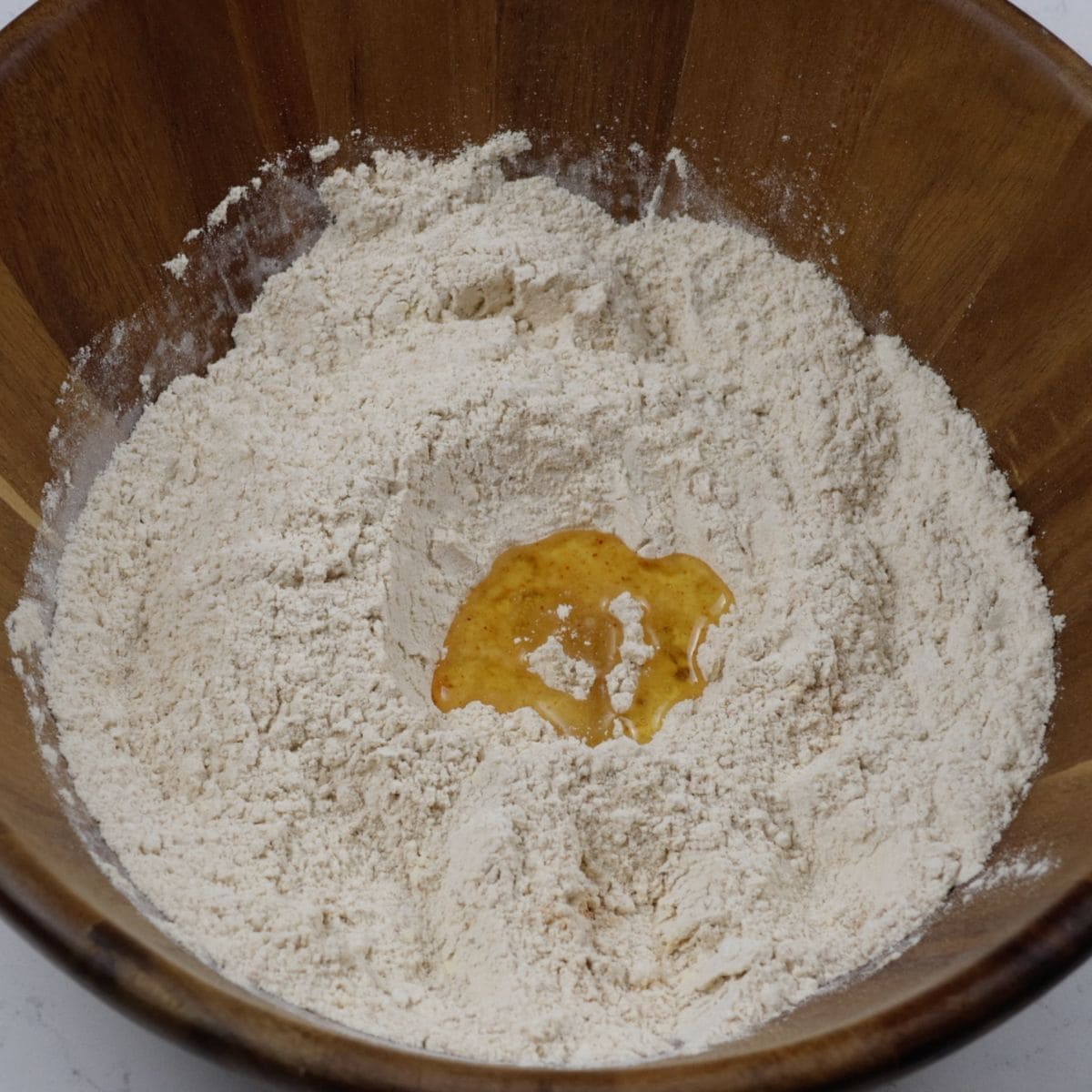

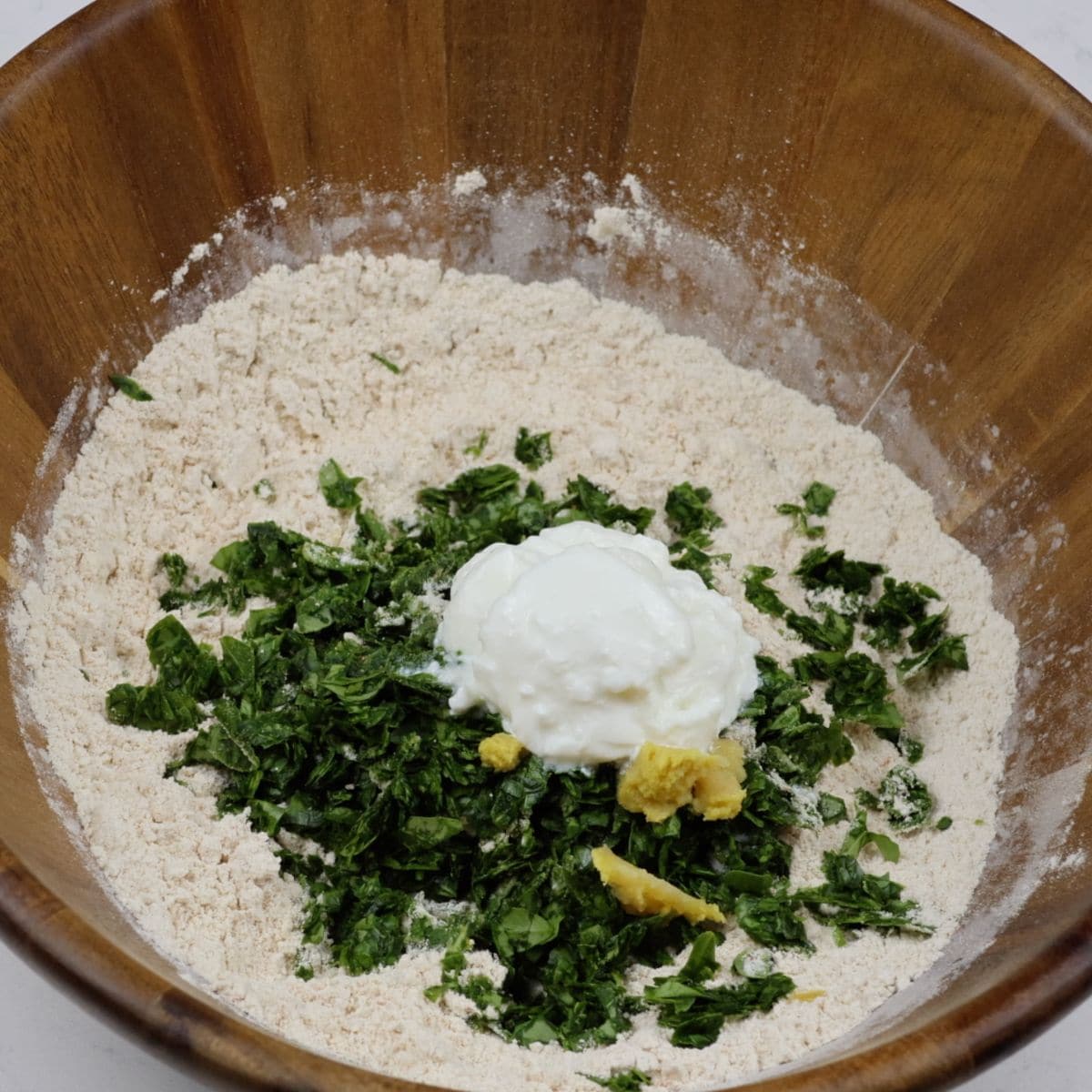

- After 15 minutes, give it another round of kneading to smooth it out.
- Make ten medium-sized balls. Roll each ball between your palms to make a circle and cover it with a cloth.


Rool & Cook Thepla
- Heat the tawa over medium heat.
- Spread out the ball and thoroughly coat it in dry chapati flour. Roll it carefully.
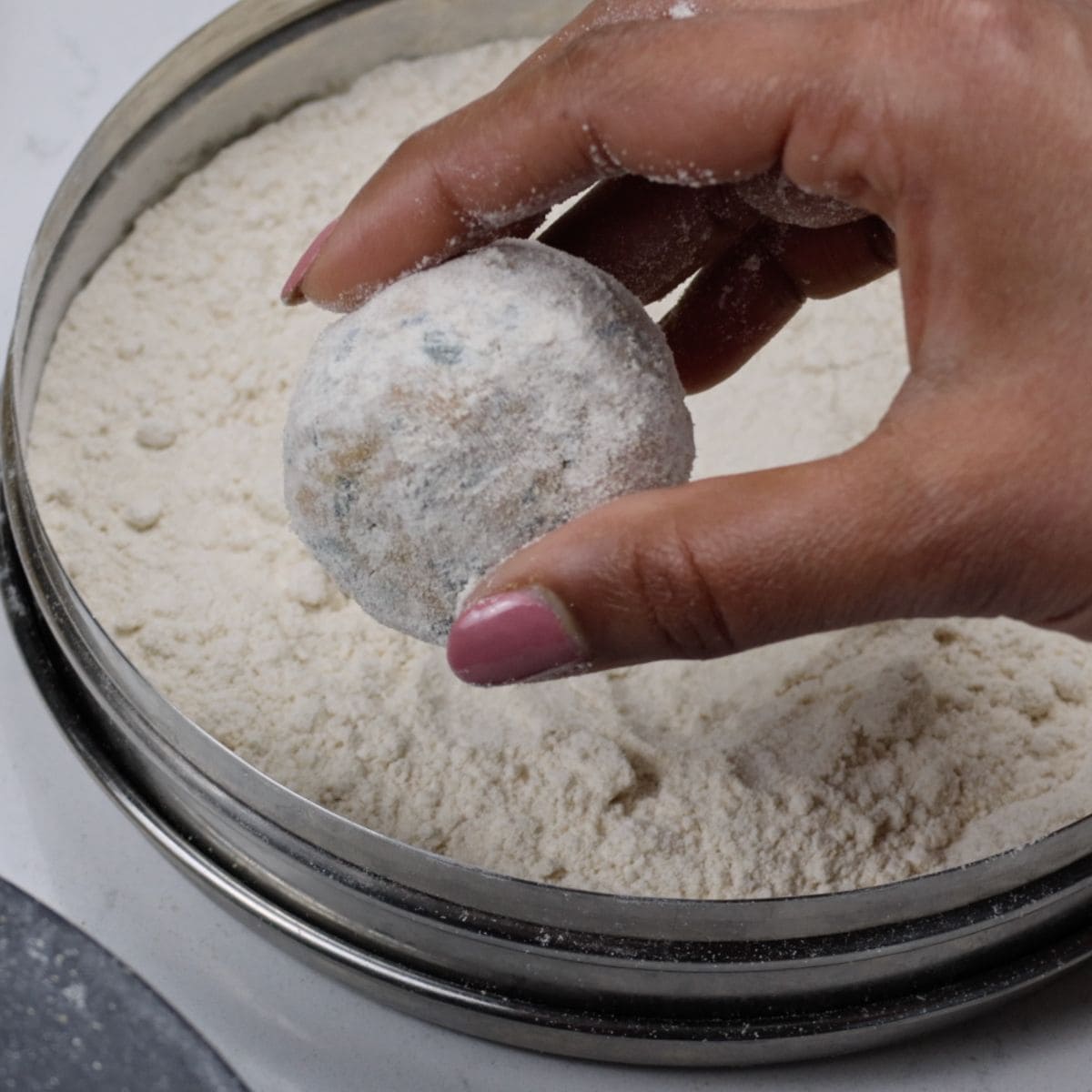

- Place the rolled thepla on the pan after it has heated well. When you see bubbles on it, you should flip it over.
- After a few seconds, spray some oil over it or spread the oil with a spoon. Flip it over, and then push lightly on it with a spatula until some brown spots appear on the bottom.
- After applying more oil to the other side, turn the thepla over and continue cooking.
- Continue to cook until the thepla is evenly golden brown on both sides with some deeper brown patches. Flip in between as needed, and cook for a minute on each side.



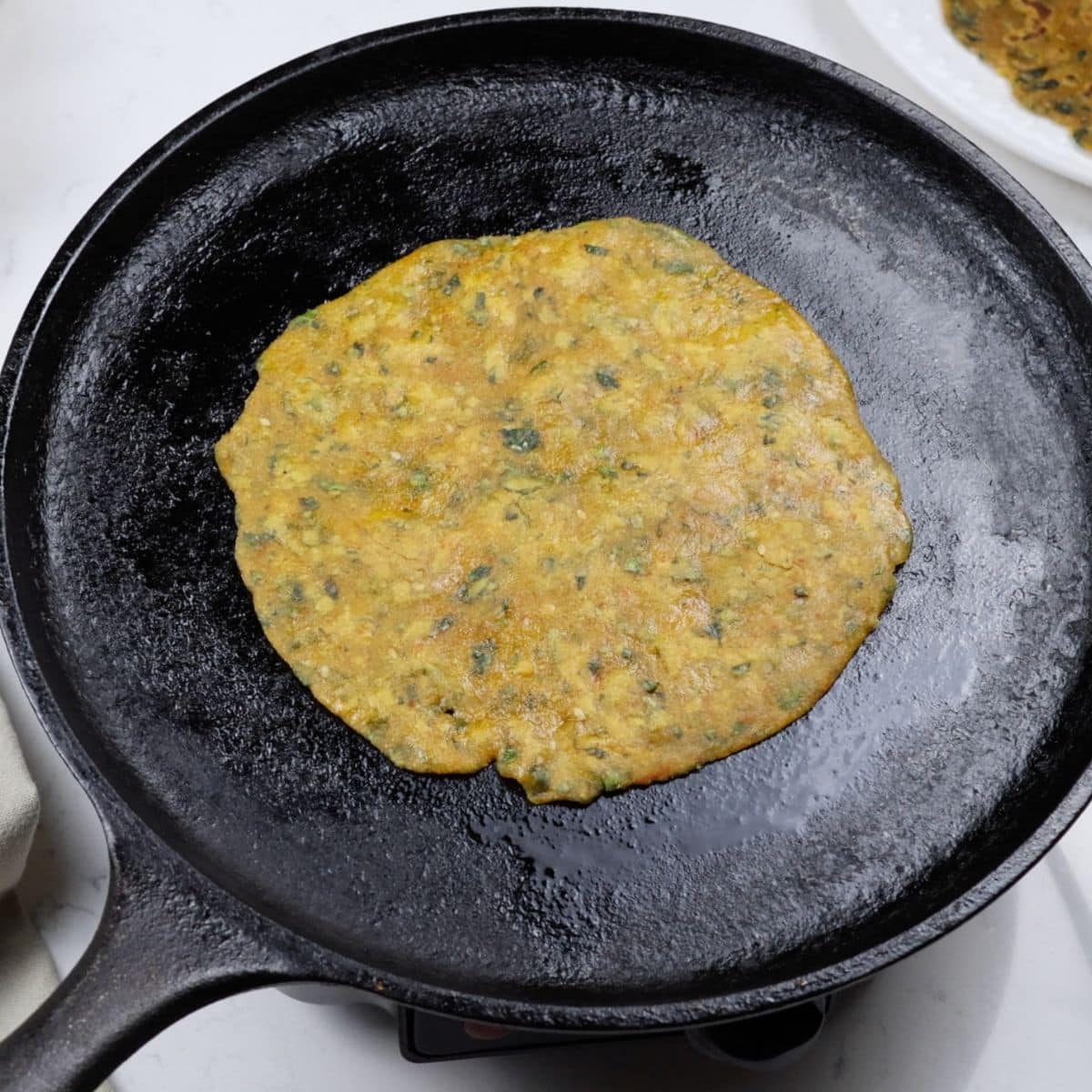
Put the thepla out of the pan on a roti basket or a platter with a lid to serve.

Serving suggestion
Methi Thepla goes well with pickled peppers (athela marcha), mango pickle or chutney, red garlic chutney, dahi (yogurt), and green chutney.
We love thepla with a cup of masala chai too.
Theplas can also be served in place of roti, with dal and batata bhaji.

Tips to make Soft Methi Theplas
- Use fresh, tender methi leaves. If the leaves are old, then they can make the thepla hard.
- Make a soft dough by kneading it well and let it rest for 15-20 minutes.
- Don’t forget to add yogurt (curd), or else the bitterness of the methi will be too much to handle. Yogurt also makes the dough softer.
- Thepla shouldn’t be cooked at a low temperature; it needs a medium-to-high flame because thepla would get hard and brittle at a low flame.
- Brush with oil or ghee to make the thepla soft.
Variations
Lauki Thepla: This is made with grated bottle gourd added to the flour along with oil, yogurt, and spices.
Using Kasoori Methi: When fresh methi leaves are not available, you can use dried kasoori methi to make thepla. Use 1/3 of the quantity as compared to fresh methi leaves, as these are much more potent.
Using other greens: You can make thepla with spinach, or kale leaves too.
How to Store Thepla?
To keep the Thepla soft for up to 24 hours, put them in a container with a lid.
If you want to eat the Theplas later, keep them in the fridge for up to 7 days in an airtight container. To reheat, put thepla in the microwave for 30 seconds, or reheat in a pan on the stovetop.
To freeze, put sheets of baking paper between each one and wrap them well in foil. Freeze for a month or more. Before reheating, let them thaw.
How to keep Thelpa fresh for travel?
To store thepla for longer at room temperature, such as when traveling, make the dough for thepla with only yogurt and no water. Also, add a little extra oil when making the dough and cooking the thepla. This helps to keep them fresh and softer for longer.
Common Questions
Of course! If you can’t find fresh methi in the summer, you can use dried fenugreek leaves instead. But when dried ones are used, the taste is a little different.
First, you should pull the leaves off the stem and set them aside. Next, rinse the methi leaves in clean water two or three times. Once cleaned, chop them up small and add them to the dough.
More Indian Flatbread Recipes
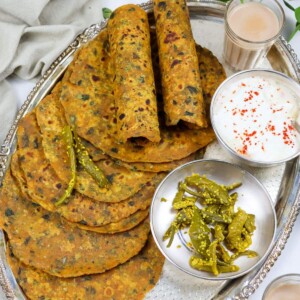
Gujarati Methi Thepla (Easy, Authentic Recipe)
Ingredients
- 1 cup Methi (Fenugreek leaves), finely chopped
- 2 cups Whole Wheat Flour
- 2 Tablespoon Gram flour (Besan)
- 1 Teaspoon White sesame seeds
- 1/4 Teaspoon Asafoetida (Hing)
- 1/2 Teaspoon Cumin Powder
- 1 Teaspoon Salt
- 1/2 Teaspoon Turmeric powder (Haldi)
- 1 Teaspoon Kashmiri red chili powder
- 1 Tablespoon Jaggery powder
- 1.5 Tablespoon Oil
- 1 Teaspoon Ginger paste
- 1 Teaspoon Garlic paste
- 1/4 cup Yogurt
- 1/2 cup Water
- Whole wheat flour for rolling
- Oil for cooking
Instructions
Prepare Methi Leaves
- First, prepare the fenugreek: Pluck the Methi leaves from the stem and wash them in cool running water. After that, completely drain them and dry them with a paper towel or kitchen towel. Finely chop the leaves, then place them aside.
Make the dough
- In a bowl, add whole wheat flour, besan, sesame seeds, ing, cumin, turmeric, red chili powder, jaggery, salt. Mix well with your fingers. Then add oil and mix again.
- Let's combine fenugreek leaves, ginger paste, garlic paste, yogurt. Mix thoroughly. Using your finger, thoroughly combine the fenugreek with the flour. The texture will be crumbly.
- Add little water at a time to make a soft dough. Allow it to stand for 10-15 minutes, covered with a damp cloth. Knead it again after 15 minutes to smooth it out.
- Make 10 medium-sized balls. Roll each ball between your palms to make a circle.
Roll & Cook Thepla
- Warm the tawa/skillet over medium heat.
- Coat the flattened ball well in dry whole wheat flour. Place it on your rolling board and gently press it down using your fingers.
- Now with the help of a rolling pin, start rolling the dough ball from the center, coming out towards the edges. Apply equal pressure on all sides while rolling. When you roll with gentle hands, the dough flattens and moves in circles with the rolling pin. Roll it carefully to about 1mm thickness.
- When the pan is heated, lay the rolled thepla on it. Flip it when you notice bubbles on it. After a few seconds, drizzle oil on it and flip it again, pressing gently with a spatula until you see some brown spots on the bottom.
- Apply more oil to the other side, flip, and cook on that side.
- Continue to cook until the thepla is evenly golden brown on both sides with some deeper brown patches. Flip in between as needed, and cook for a minute on each side.
- When done, remove from skillet/tawa and repeat until all of the dough is used up.
Notes
- To make a soft dough, let it rest for 15-20 minutes after kneading.
- Don’t forget to add yogurt (curd), or else the bitterness of the methi will be too much to handle.
- Place thepla in an airtight container to keep them soft for up to 24 hours.
- Thepla should not be cooked at a low temperature; it requires a medium-to-high flame since it becomes hard and brittle when cooked at a low temperature.
- If you want to eat the Theplas later, keep them in the fridge for up to 7 days in an airtight container. To reheat, put thepla in the microwave for 30 seconds, or reheat in a pan on the stovetop.





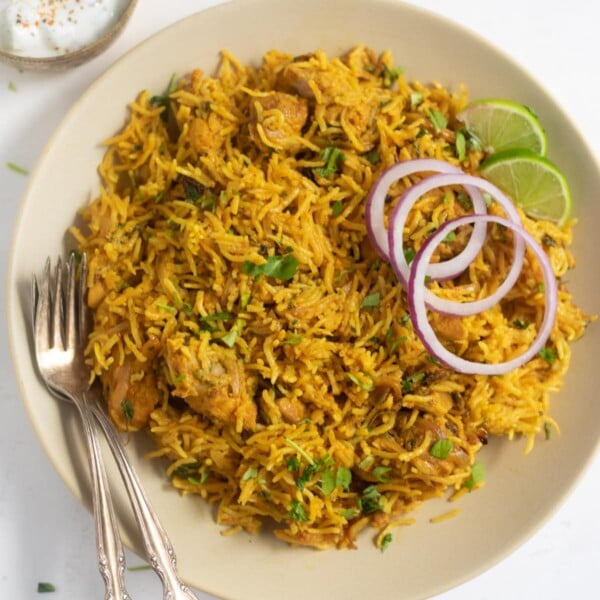








easy and excellent
Hi- Thank you 🙂